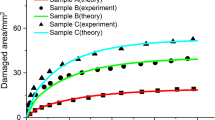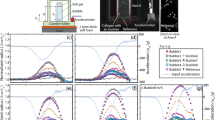Abstract
When cavitating bubbles grow in a soft material followed by a violent collapse under the influence of a far-field pressure, they generate secondary pressure pulses of higher magnitude and potentially induce damage to the near-field material. During the bubble collapse, the surrounding material also experiences a high strain rate and shear deformation. Several experimental and analytical observations have shown that the bubble dynamics are highly dependent on the magnitude of the far-field pressure, the volume fraction of non-condensable gas, and material properties. In the present work, we propose a damage parameter as the efficiency of cavitation damage and perform several numerical simulations varying the factors mentioned above to establish a correlation with the damage efficiency. The efficiency of cavitation damage is defined as the ratio of the energy deposited to the surrounding medium and the energy released by the collapsing bubbles. We consider both isotropic (volumetric) and deviatoric (shear) energy deposition, and in doing so, we can separately identify the intensity of both damage mechanisms. For the numerical simulations, we have integrated the viscoelastic Kelvin–Voigt constitutive model with a commercially available solver. The significant findings of the numerical simulations are (1) bubble collapse becomes more violent with the increase of far-field pressure, (2) collapse pressure and intensity decrease with increasing non-condensable gas content, (3) materials elasticity reduces the collapsing velocity, and eventually, the collapsing pressure, (4) viscosity plays a minor role in the first collapse and becomes significant for the subsequent rebounds and collapses.




















Similar content being viewed by others
References
C.E. Brennen, Cavitation and Bubble Dynamics (Cambridge University Press, Cambridge, 2014).
A. Andersen, K.A. Mørch, Cavitation nuclei in water exposed to transient pressures. J. Fluid Mech. 771, 424–448 (2015)
T.G. Leighton, The principles of cavitation. Ultrasound food Process 12, 151–178 (1998)
M.S. Plesset, The dynamics of cavitation bubbles. J. Appl. Mech. 16, 277–282 (1949)
M.S. Plesset, A. Prosperetti, Bubble dynamics and cavitation. Annu. Rev. Fluid Mech. 9(1), 145–185 (1977)
A. Prosperetti, A generalization of the Rayleigh–Plesset equation of bubble dynamics. Phys. Fluids 25(3), 409–410 (1982)
L. Rayleigh, VIII. On the pressure developed in a liquid during the collapse of a spherical cavity. Lond. Edinb. Dublin Philos. Mag. J. Sci. 34(200), 94–98 (1917)
J. Goeller, A. Wardlaw, D. Treichler, J. O’Bruba, G. Weiss, Investigation of cavitation as a possible damage mechanism in blast-induced traumatic brain injury. J. Neurotrauma 29(10), 1970–1981 (2012). https://doi.org/10.1089/neu.2011.2224
A. Nakagawa et al., Mechanisms of primary blast-induced traumatic brain injury: insights from shock-wave research. J. Neurotrauma 28(6), 1101–1119 (2011). https://doi.org/10.1089/neu.2010.1442
P.A. Taylor, J.S. Ludwigsen, C.C. Ford, Investigation of blast-induced traumatic brain injury. Brain Inj. 28(7), 879–895 (2014). https://doi.org/10.3109/02699052.2014.888478
L. Zhang, K.H. Yang, A.I. King, Comparison of brain responses between frontal and lateral impacts by finite element modeling. J. Neurotrauma 18(1), 21–30 (2001). https://doi.org/10.1089/089771501750055749
L. Zhang, K.H. Yang, A.I. King, A proposed injury threshold for mild traumatic brain injury. J. Biomech. Eng. 126(2), 226–236 (2004). https://doi.org/10.1115/1.1691446
W. Yuan-Ting, A. Adnan, Effect of shock-induced cavitation bubble collapse on the damage in the simulated perineuronal net of the brain. Sci. Rep. (Nat. Publ. Group) 7, 1–9 (2017)
M.I. Khan, F. Hasan, K.A.H. AlMahmud, A. Adnan, Recent computational approaches on mechanical behavior of axonal cytoskeletal components of neuron: a brief review. Eng. Multiscale Sci. (2020). https://doi.org/10.1007/s42493-020-00043-4
M.I. Khan, F. Hasan, K. A. Hasan Al Mahmud, A. Adnan, , Domain focused and residue focused phosphorylation effect on tau protein: a molecular dynamics simulation study. J. Mech. Behav. Biomed. Mater. 113, 104149 (2021). https://doi.org/10.1016/j.jmbbm.2020.104149
J.A. Zimberlin et al., Cavitation rheology for soft materials. Soft Matter 3(6), 763 (2007). https://doi.org/10.1039/b617050a
J.B. Estrada, C. Barajas, D.L. Henann, E. Johnsen, C. Franck, High strain-rate soft material characterization via inertial cavitation. J. Mech. Phys. Solids 112, 291–317 (2018)
W. Kang, A. Adnan, T. O’Shaughnessy, A. Bagchi, Cavitation nucleation in gelatin: experiment and mechanism. Acta Biomater. 67, 295–306 (2018). https://doi.org/10.1016/j.actbio.2017.11.030
C.C. Coussios, R.A. Roy, Applications of acoustics and cavitation to noninvasive therapy and drug delivery. Annu. Mech. 40, 395–420 (2008)
G.A. Husseini, M.A.D. de la Rosa, E.S. Richardson, D.A. Christensen, W.G. Pitt, The role of cavitation in acoustically activated drug delivery. J. Control. Release 107(2), 253–261 (2005)
S. Mitragotri, Healing sound: the use of ultrasound in drug delivery and other therapeutic applications. Nat. Rev. Drug Discov. 4(3), 255 (2005)
W.G. Pitt, G.A. Husseini, B.J. Staples, Ultrasonic drug delivery—a general review. Expert Opin. Drug Deliv. 1(1), 37–56 (2004)
C.C. Church, A theoretical study of cavitation generated by an extracorporeal shock wave lithotripter. J. Acoust. Soc. Am. 86(1), 215–227 (1989)
A.J. Coleman, J.E. Saunders, L.A. Crum, M. Dyson, Acoustic cavitation generated by an extracorporeal shockwave lithotripter. Ultrasound Med. Biol. 13(2), 69–76 (1987)
Y.A. Pishchalnikov et al., Cavitation bubble cluster activity in the breakage of kidney stones by lithotripter shockwaves. J. Endourol. 17(7), 435–446 (2003)
K.A.H. Al Mahmud, F. Hasan, M.I. Khan, A. Adnan, On the molecular level cavitation in soft gelatin hydrogel. Sci. Rep. 10(1), 9635 (2020). https://doi.org/10.1038/s41598-020-66591-9
P. Lubock, W. Goldsmith, Experimental cavitation studies in a model head-neck system. J. Biomech. 13(12), 1041–1052 (1980)
G.S. Nusholtz, E.B. Wylie, L.G. Glascoe, Internal cavitation in simple head impact model. J. Neurotrauma 12(4), 707–714 (1995)
D.F. Moore, R.A. Radovitzky, L. Shupenko, A. Klinoff, M.S. Jaffee, J.M. Rosen, Blast physics and central nervous system injury (2008).
A. Thiruvengadam (1966) On modeling cavitation damage. Washington DC, (1966) [Online]. https://apps.dtic.mil/sti/pdfs/AD0810327.pdf. Accessed 26 Feb 2021
D.W. Hyde, CONWEP 2.1. 0.8, Conventional Weapons Effects Program. Vicksburg, MS United States Army Corps Eng (2004)
R.K. Gupta, A. Przekwas, Mathematical models of blast-induced TBI: current status, challenges, and prospects. Front. Neurol. 4, 1–21 (2013). https://doi.org/10.3389/fneur.2013.00059
C. Ward, M. Chan, A. Nahum, Intracranial pressure—a brain injury criterion. SAE Trans. 89(4), 3867–3880 (1980)
M.S. Plesset, Shockwaves from cavity collapse. Philos. Trans. R. Soc. Lond. Ser. A Math. Phys. Sci 260(1110), 241–244 (1966)
W.-J. Yang, H.-C. Yeh, Theoretical study of bubble dynamics in purely viscous fluids. AIChE J. 12(5), 927–931 (1966). https://doi.org/10.1002/aic.690120517
A. Balasubramanya, S. Kohlstädt, H. Nilsson, Viscoelasticity and constitutive relations. Foamextend 3(2), 1–28 (2016)
M.T. Warnez, E. Johnsen, Numerical modeling of bubble dynamics in viscoelastic media with relaxation. Phys. Fluids 27(6), 63103 (2015). https://doi.org/10.1063/1.4922598
B. Dollet, P. Marmottant, V. Garbin, Bubble dynamics in soft and biological matter. Annu. Rev. Fluid Mech. 51, 331–355 (2019)
X. Yang, C.C. Church, A model for the dynamics of gas bubbles in soft tissue. J. Acoust. Soc. Am. 118(6), 3595–3606 (2005). https://doi.org/10.1121/1.2118307
R. Gaudron, M.T. Warnez, E. Johnsen, Bubble dynamics in a viscoelastic medium with nonlinear elasticity. J. Fluid Mech. 766, 54–75 (2015). https://doi.org/10.1017/jfm.2015.7
C.C. Church, Spontaneous homogeneous nucleation, inertial cavitation and the safety of diagnostic ultrasound. Ultrasound Med. Biol. 28(10), 1349–1364 (2002). https://doi.org/10.1016/S0301-5629(02)00579-3
S. Fujikawa, T. Akamatsu, Effects of the non-equilibrium condensation of vapour on the pressure wave produced by the collapse of a bubble in a liquid. J. Fluid Mech. 97(3), 481–512 (1980). https://doi.org/10.1017/S0022112080002662
R. Hicking, M.S. Plesset, R. Hickling, M.S. Plesset, Collapse and rebound of a spherical bubble in water. Phys. Fluids 7(1), 7–14 (1964). https://doi.org/10.1063/1.1711058
J.B. Keller, M. Miksis, Bubble oscillations of large amplitude. J. Acoust. Soc. Am. 68(2), 628–633 (1980)
E. Lauer, X.Y. Hu, S. Hickel, N.A. Adams, Numerical modelling and investigation of symmetric and asymmetric cavitation bubble dynamics. Comput. Fluids 69, 1–19 (2012)
A. Pearson, E. Cox, J.R. Blake, S.R. Otto, Bubble interactions near a free surface. Eng. Anal. Bound. Elem. 28(4), 295–313 (2004)
T.B. Benjamin, A.T. Ellis, The collapse of cavitation bubbles and the pressures thereby produced against solid boundaries. Philos. Trans. R. Soc. Lond. Ser. A Math. Phys. Sci. 260(1110), 221–240 (1966)
J.R. Blake, D.C. Gibson, Cavitation bubbles near boundaries. Annu. Rev. Fluid Mech. 19(1), 99–123 (1987). https://doi.org/10.1146/annurev.fluid.19.1.99
ANSYS (R) Academic Research Mechanical and CFD, Release 19.1.
ANSYS (R) Academic Research Mechanical and CFD, Release 19.1, Fluent User Guide.
F. Habla, H. Marschall, O. Hinrichsen, L. Dietsche, H. Jasak, J.L. Favero, Numerical simulation of viscoelastic two-phase flows using openFOAM®. Chem. Eng. Sci. 66(22), 5487–5496 (2011). https://doi.org/10.1016/j.ces.2011.06.076
Z.-Y. Zheng, F.-C. Li, J.-C. Yang, Modeling asymmetric flow of viscoelastic fluid in symmetric planar sudden expansion geometry based on user-defined function in FLUENT CFD package. Adv. Mech. Eng. 5, 795937 (2013). https://doi.org/10.1155/2013/795937
F. Belblidia, I.J. Keshtiban, M.F. Webster, Stabilised computations for viscoelastic flows under compressible implementations, in 2nd Annu. Eur. Rheol. Conf., vol. 134(1), (2006), pp. 56–76. https://doi.org/10.1016/j.jnnfm.2005.12.003
P.C. Bollada, T.N. Phillips, On the mathematical modelling of a compressible viscoelastic fluid. Arch. Ration. Mech. Anal. 205(1), 1–26 (2012). https://doi.org/10.1007/s00205-012-0496-5
M.S. Darwish, J.R. Whiteman, M.J. Bevis, Numerical modelling of viscoelastic liquids using a finite-volume method. J. Nonnewton. Fluid Mech. 45(3), 311–337 (1992)
M.F. Tomé, M.S.B. de Araujo, M.A. Alves, F.T. Pinho, Numerical simulation of viscoelastic flows using integral constitutive equations: a finite difference approach. J. Comput. Phys. 227(8), 4207–4243 (2008)
W. Lauterborn, C.D. Ohl, Cavitation bubble dynamics. Ultrason. Sonochem. (1997). https://doi.org/10.1016/S1350-4177(97)00009-6
A. Thiruvengadam, A unified theory of cavitation damage. J Basic Eng 3, 365 (1963)
C.E. Brennen, Cavitation and bubble dynamics. Cambridge University Press (2014)
V.P. Carey, Liquid-Vapor Phase-Change Phenomena: An Introduction to the Thermophysics of Vaporization and Condensation Processes in Heat Transfer Equipment (CRC Press, Boca Raton, 2020).
ANSYS (R) Academic Research Mechanical and CFD, Release 19.1, Fluent Theory Guide.
P. Movahed, W. Kreider, A.D. Maxwell, S.B. Hutchens, J.B. Freund, Cavitation-induced damage of soft materials by focused ultrasound bursts: a fracture-based bubble dynamics model. J. Acoust. Soc. Am. 140(2), 1374–1386 (2016). https://doi.org/10.1121/1.4961364
F. Hamaguchi, K. Ando, Linear oscillation of gas bubbles in a viscoelastic material under ultrasound irradiation. Phys. Fluids 27(11), 113103 (2015). https://doi.org/10.1063/1.4935875
S. Catheline, Measurement of viscoelastic properties of homogeneous soft solid using transient elastography: an inverse problem approach. J. Acoust. Soc. Am. 116(6), 3734–3741 (2020)
L. Liu, Y. Fan, W. Li, Viscoelastic shock wave in ballistic gelatin behind soft body armor. J. Mech. Behav. Biomed. Mater. 34, 199–207 (2014). https://doi.org/10.1016/j.jmbbm.2014.02.011
V.T. Nayar, J.D. Weiland, C.S. Nelson, A.M. Hodge, Elastic and viscoelastic characterization of agar. J. Mech. Behav. Biomed. Mater. 7, 60–68 (2012). https://doi.org/10.1016/j.jmbbm.2011.05.027
J. Zhang, C.R. Daubert, E.A. Foegeding, Characterization of polyacrylamide gels as an elastic model for food gels. Rheol. Acta 44(6), 622–630 (2005). https://doi.org/10.1007/s00397-005-0444-5
T.G. Goktekin, Animating Viscoelastic Fluids (University of California, Berkeley, 2011).
D. Chakraborty, J.E. Sader, Constitutive models for linear compressible viscoelastic flows of simple liquids at nanometer length scales. Phys. Fluids (2015). https://doi.org/10.1063/1.4919620
H.S. Kang, R. Willinger, B.M. Diaw, B. Chinn, Validation of a 3D anatomic human head model and replication of head impact in motorcycle accident by finite element modeling. SAE Trans. 106(6), 3849–3858 (1997)
S. Kleiven, Predictors for traumatic brain injuries evaluated through accident reconstructions. SAE Technical Paper, No. 2007-22-0003 (2007)
C. Deck, R. Willinger, Improved head injury criteria based on head FE model. Int. J. Crashworthiness (2008). https://doi.org/10.1080/13588260802411523
A.I. King, K.H. Yang, L. Zhang, W. Hardy, D.C. Viano, Is head injury caused by linear or angular acceleration? in Proceedings of the International Research Conference on the Biomechanics of Impacts (IRCOBI), pp. 1–12 (2003)
H.F. Brinson, L.C. Brinson, Polymer Engineering Science and Viscoelasticity (Springer, Boston, 2008)
E. Johnsen, L. Mancia, Bubble dynamics in soft materials: viscoelastic and thermal effects. J. Phys. Conf. Ser. (2015). https://doi.org/10.1088/1742-6596/656/1/012022
Author information
Authors and Affiliations
Corresponding author
Additional information
Publisher's Note
Springer Nature remains neutral with regard to jurisdictional claims in published maps and institutional affiliations.
Supplementary Information
Below is the link to the electronic supplementary material.
Rights and permissions
About this article
Cite this article
Hasan, F., Al Mahmud, K.A.H., Khan, M.I. et al. Cavitation Induced Damage in Soft Biomaterials. Multiscale Sci. Eng. 3, 67–87 (2021). https://doi.org/10.1007/s42493-021-00060-x
Received:
Revised:
Accepted:
Published:
Issue Date:
DOI: https://doi.org/10.1007/s42493-021-00060-x




